Eastern Canada’s Krsna Culture
The traditional chanting, dancing, and worship
are all going strong, but there’s much more . . .
by Amogha Dasa

About a decade ago the Hare Krsna devotees in Canada bought two churches—one in Toronto and one in Montreal—and caused a bit of consternation. Their neighbors wondered just who they were and what they were going to do.
Today these fears are gone. Krsna consciousness has become firmly established in eastern Canada—not just in Toronto and Montreal but also in the nation’s capital, Ottawa—and the large incandescent HARE KRISHNA sign on the high stone walls of the Toronto temple raises hardly an eyebrow among the people in some 25.000 cars that pass by each day.
Still, for many Canadians the questions remain: What do the Hare Krsnas do? And why?

Nandikesvara dasa, president of the center in Montreal, explained, “We live according to the Vedic scriptures, such as Bhagavad-gita and Srimad-Bhagavatam. These books were introduced here in the late sixties and early seventies by His Divine Grace A.C. Bhaktivedanta Swami Prabhupada, the founder and spiritual guide of the Hare Krsna movement. He translated them from the original Sanskrit and explained them in elaborate purports. To understand our activities here in eastern Canada, you have to understand something of the principles laid down in these scriptures.”,
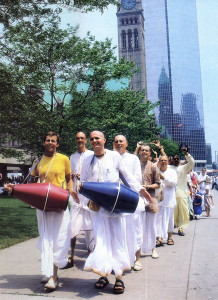
And what are those principles? “In the Bhagavad-gita Lord Krsna says, ‘All that you do, all that you eat, and all austerities you may perform should be offerings to Me. In this way you will become free from karmic reactions and come back to Me in the spiritual world.’ Everything we do is guided by this principle of making it an offering to Lord Krsna. This is he basis of the whole culture of Krsna consciousness.”
For several weeks last summer I lived with the Canadian devotees and saw how they put these principles into practice.
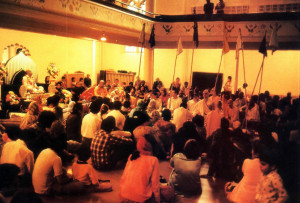
As in all Hare Krsna temples, the devotees in Canada begin the day at 4:30 in the morning with a formal arati ceremony. Accompanying themselves on drums and hand cymbals, they sing prayers to the spiritual master, a pure representative of Krsna and the devotees’ spiritual guide and source of inspiration. Then they chant the Hare Krsna mantra in chorus.
Arati is a ceremony for greeting the Lord, who dwells in the temple in His Deity form. (To the uninitiated. He looks like a stone statue.) Visvakarma dasa, president of the Toronto center, explained, “Krsna is eternally manifest in His spiritual form in the spiritual world, far beyond the material universes, and He is within the heart of every living being in another spiritual form, the Supersoul. But we can’t see His spiritual form with our material eyes. So for the benefit of us conditioned souls and aspiring devotees, Lord Krsna appears in His spiritual form within a form made of matter so that we can see and serve Him. A bona fide spiritual master installs the Deity in the temple and prays to the Lord to please appear there. And when we come before the Deity of the Lord and worship Him and chant His name, we feel Krsna’s personal presence.”
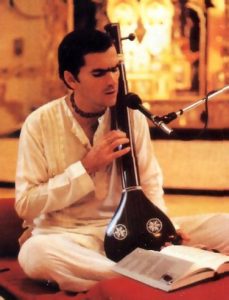
For an hour and a half after the arati softly on beads (see page 4 for more details). Then it’s time for a class in the Srimad-Bhagavatam. Laksminatha dasa, president of the center in Ottawa, told us of its significance: “By hearing the Bhagavatam every morning, we feel tangible spiritual improvement. The Bhagavatam is the foremost of all Vedic literatures because it deals with nothing except the instructions and activities of Lord Krsna and His devotees. The Lord is within each of us, and, as the Bhagavatam itself explains, He purifies our heart and gives us transcendental knowledge when we regularly hear about Him. Ultimately He reveals Himself to us. So the morning Bhagavatam class is a vital part of every devotee’s practice of Krsna consciousness.”
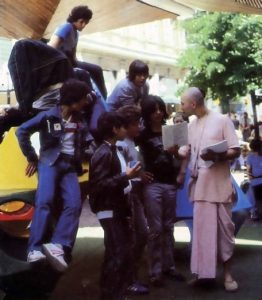
During the Bhagavatam class the temple cooks are busy at work in the kitchen, listening to class via loudspeakers. Krpa-sindhu dasa, a cook at the Montreal center, explained the philosophy behind cooking for Krsna: “As Krsna says in the Gita, ‘Everything you eat should be an offering to Me.’ So the food we cook in this kitchen is all for Krsna’s pleasure. That’s why we cook only vegetarian food—because that’s what Krsna asks for in the Gita. When the meal is ready, a priest will arrange it on special plates used only for Krsna. Then he’ll take the plates into the Deity room, place them before the Lord, and offer Sanskrit prayers asking Him to please accept the offering. Devotees eat only food that has first been offered to Krsna. Such food is called prasadam, ‘the Lord’s mercy.’ “
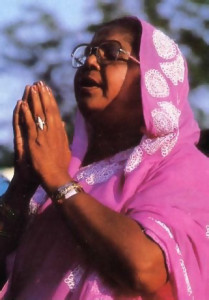
After the class, everyone rises to sing more prayers glorifying the spiritual master. Then it’s breakfast time, followed by the start of the day’s devotional activities.
Visvakarma told us how the devotees offer their work to Krsna thoroughout the day: “Some manage the temple accounts, some maintain the temple grounds and clean the temple itself. Some go out to distribute Krsna conscious literature—BACK TO GODHEAD magazine or books by Srila Prabhupada or his followers. Some go to high schools and universities to tell students and their teachers about our philosophy and way of life. In Ottawa and Montreal we have vegetarian restaurants that serve prasadam to hundreds daily, and many devotees work in them. Then there are our acting troupes, who put on Krsna conscious dramas. We also have artists and musicians and dancers who create or perform for Krsna. And, of course, we send out a group of devotees every day to chant Hare Krsna on the city streets so that everyone can hear and benefit.”
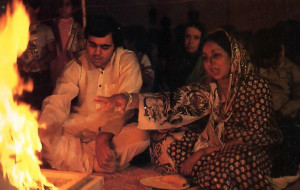
Visvakarma also told me about his large congregation of Indian life members. They’ve seen that the devotees are following the genuine Vedic culture, so they enthusiastically support the temple. Two members, Syama-Krsna dasa and his wife, Kunti-devi dasi, recently took spiritual initiation from Srila Gopala Krsna Go-swami, who oversees the movement’s affairs in Canada and initiates new disciples there.
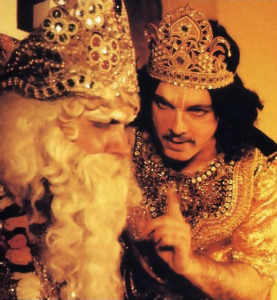
Kunti-devi explained how they decided to take the step of accepting formal initiation: “When we started reading BACK TO GODHEAD, we used to read about everyday people pursuing Krsna consciousness. And that made us think, ‘Well, what is there to stop us? If ordinary people like us can do it, why should we hesitate?’ Reading BACK TO GODHEAD was wonderful.”
Her husband added, “What inspired us was that we saw that we didn’t have to give up our regular life. We could carry on with that and yet advance spiritually and make Krsna the center of our life. We could do everything for Krsna and help spread Krsna consciousness.”
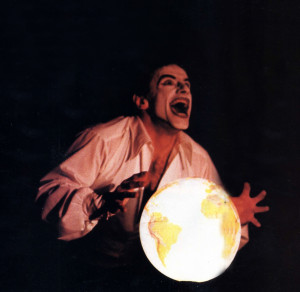
To find out about the Krsna conscious drama being performed in Canada, I talked to Nanda-kisora dasa in Montreal, He’s been putting on plays about Krsna for ten years, and now he’s directing a production based on the Mahabharata, India’s great epic poem of 110,000 couplets. The Mahabharata relates a complex scries of political events that culminated fifty centuries ago in the Battle of Kuruksetra, a devastating war of royal succession in which Lord Krsna Himself took part. The Bhagavad-gita is part of the Mahabharata.
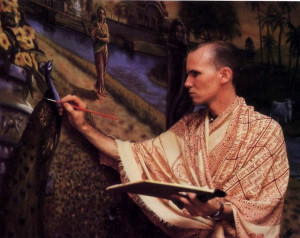
“Dramatizing the Mahabharata is like sculpting,” said Nanda-kisora. “The entire story is like a large stone that must be cut and formed into a play that presents the essence of the work. Ideally the finished production should be so absorbing that the audience should forget they’re watching a play. They should be drawn into what’s happening onstage as if it were real life.” The production I saw did just that: the members of the audience were transfixed by the play, fully absorbed in Krsna consciousness.
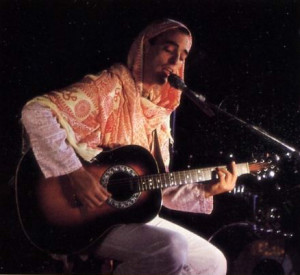
I also learned that another troupe, in Toronto, puts on a play based on the Ramayana, the epic about Krsna’s incarnation Lord Ramacandra. And I heard that one devotee performs ballet and classical Indian dance to portray the Lord’s pastimes.
I knew my visit wouldn’t be complete without stopping at one of the prasadam restaurants. Nandikesvara showed me around Chez Govinda in Montreal. He suggested I try the Tofu Burger, a favorite among patrons.
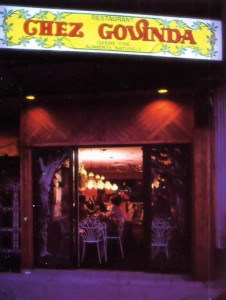
I could hardly hold it in my hands, let alone fit it into my mouth, but somehow I chomped into it. Wonderful! Between light, homemade whole-wheat buns was a base layer of sour cream sauce, then lettuce, a slice of tomato, a half-inch-thick fried tofu patty, alfalfa sprouts, thick melted cheese, and then tomato sauce—all bulging out. It was exquisitely delicious!
“That’s just for a start,” said Nandikesvara, laughing as I grappled with the expansive munchie. “Now this is the Cosmic Special.” It was an eight-inch-wide capati (a round, whole-wheat tortilla) decked with thick avacado puree, tomato slices, melted cheese, sunflower seeds, and fresh alfalfa sprouts.

“What do you think of that?” Nandikesvara asked.
“Fantastic!”
Next I asked Punyakirti dasa, who manages Chez Govinda, about the restaurant’s interior.
“The devotees did it all themselves,” he told me.” Abhay Charan made the wrought-iron table legs and matching chairs, Dana-keli did the plumbing, wiring, and kitchen installations, and Visnu dasa hand-painted the wall mural.” This monumental piece of artwork consists of seventeen panels separated by hand-cast columns and arches.

“As the mural shows,” Punyakirti continued, “the kingdom of God is a place of beauty and peace, where everyone lives together without trouble—unlike the material world, where there is constant fear, strife, and exploitation. But when we make Krsna the center of our lives, even this world can be peaceful and harmonious. All up and down the street there are many restaurants, but they’re full of violence because they’re serving meat—dismembered carcasses. Here we serve only vegetarian foods offered to Krsna. So the mural isn’t just an expression of wishful thinking. This actually is a place of peace, and because all the food is cooked for Lord Krsna and offered to Him, all our patrons get incalculable spiritual benefit as well.”
Unfortunately, I never did get to visit the Back Home Buffet, the devotees’ restaurant in Ottawa, where I heard they serve a different national vegetarian food every day: Italian food one day, Indian the next, Mexican the next, then Oriental, then American. Maybe I could go back and do a special article just on the Ottawa restaurant. Of course, I’d have to sample all the national dishes . . .
In any case, from what I saw of the Hare Krsna devotees in eastern Canada, far from bringing consternation to their neighbors, they’re winning congratulations. The temple programs, the restaurants, the art, music, drama, and dance, what to speak of the summer celebrations like The Festival of the Chariots and Lord Krsna’s Appearance Day, all add up to a multifaceted expression of Krsna culture that has something to please everyone.

Leave a Reply